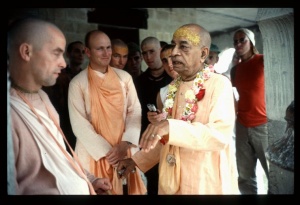CC Adi 2.97: Difference between revisions
m (1 revision(s)) |
No edit summary |
||
| Line 1: | Line 1: | ||
{{ | [[Category:Sri Caitanya-caritamrta - Adi-lila Chapter 02|C097]] | ||
<div style="float:left">'''[[Sri Caitanya-caritamrta|Śrī Caitanya-caritāmṛta]] - [[CC Adi|Ādi-līlā]] - [[CC Adi 2|Chapter 2: Śrī Caitanya Mahāprabhu Is the Supreme Personality of Godhead]]'''</div> | |||
<div style="float:right">[[File:Go-previous.png|link=CC Adi 2.96|Ādi-līlā 2.96]] '''[[CC Adi 2.96|Ādi-līlā 2.96]] - [[CC Adi 2.98|Ādi-līlā 2.98]]''' [[File:Go-next.png|link=CC Adi 2.98|Ādi-līlā 2.98]]</div> | |||
{{CompareVersions|CC|Adi 2.97|CC 1975|CC 1996}} | |||
{{RandomImage}} | |||
==== TEXT 97 ==== | ==== TEXT 97 ==== | ||
<div | <div class="verse"> | ||
kṛṣṇera svarūpera haya ṣaḍ-vidha vilāsa | :kṛṣṇera svarūpera haya ṣaḍ-vidha vilāsa | ||
prābhava-vaibhava-rūpe dvi-vidha prakāśa | :prābhava-vaibhava-rūpe dvi-vidha prakāśa | ||
</div> | </div> | ||
| Line 12: | Line 16: | ||
==== SYNONYMS ==== | ==== SYNONYMS ==== | ||
<div | <div class="synonyms"> | ||
''kṛṣṇera''—of Lord Kṛṣṇa; ''svarūpera''—of the form; ''haya''—there are; ''ṣaṭ-vidha''—six kinds; ''vilāsa''—pastime forms; ''prābhava-vaibhava-rūpe''—in the divisions of ''prābhava'' and ''vaibhava''; ''dvi-vidha''—two kinds; ''prakāśa''—manifestations. | |||
</div> | </div> | ||
| Line 19: | Line 23: | ||
==== TRANSLATION ==== | ==== TRANSLATION ==== | ||
<div | <div class="translation"> | ||
“The Personality of Godhead Śrī Kṛṣṇa enjoys Himself in six primary expansions. His two manifestations are prābhava and vaibhava. | “The Personality of Godhead Śrī Kṛṣṇa enjoys Himself in six primary expansions. His two manifestations are prābhava and vaibhava. | ||
</div> | </div> | ||
| Line 26: | Line 30: | ||
==== PURPORT ==== | ==== PURPORT ==== | ||
<div | <div class="purport"> | ||
Now the author of Śrī Caitanya-caritāmṛta turns to a description of the Personality of Godhead Kṛṣṇa in His innumerable expansions. The Lord primarily expands Himself in two categories, namely prābhava and vaibhava. The prābhava forms are fully potent like Śrī Kṛṣṇa, and the vaibhava forms are partially potent. The prābhava forms are manifested in relation with potencies, but the vaibhava forms are manifested in relation with excellences. The potent prābhava manifestations are also of two varieties: temporary and eternal. The Mohinī, Haṁsa and Śukla forms are manifested only temporarily, in terms of a particular age. Among the other prābhavas, who are not very famous according to the material estimation, are Dhanvantari, Ṛṣabha, Vyāsa, Dattātreya and Kapila. Among the vaibhava-prakāśa forms are Kūrma, Matsya, Nara-Nārāyaṇa, Varāha, Hayagrīva, Pṛśnigarbha, Baladeva, Yajña, Vibhu, Satyasena, Hari, Vaikuṇṭha, Ajita, Vāmana, Sārvabhauma, Ṛṣabha, Viṣvaksena, Dharmasetu, Sudhāmā, Yogeśvara and Bṛhadbhānu. | Now the author of ''Śrī Caitanya-caritāmṛta'' turns to a description of the Personality of Godhead Kṛṣṇa in His innumerable expansions. The Lord primarily expands Himself in two categories, namely ''prābhava'' and ''vaibhava''. The ''prābhava'' forms are fully potent like Śrī Kṛṣṇa, and the ''vaibhava'' forms are partially potent. The ''prābhava'' forms are manifested in relation with potencies, but the ''vaibhava'' forms are manifested in relation with excellences. The potent ''prābhava'' manifestations are also of two varieties: temporary and eternal. The Mohinī, Haṁsa and Śukla forms are manifested only temporarily, in terms of a particular age. Among the other ''prābhavas'', who are not very famous according to the material estimation, are Dhanvantari, Ṛṣabha, Vyāsa, Dattātreya and Kapila. Among the ''vaibhava-prakāśa'' forms are Kūrma, Matsya, Nara-Nārāyaṇa, Varāha, Hayagrīva, Pṛśnigarbha, Baladeva, Yajña, Vibhu, Satyasena, Hari, Vaikuṇṭha, Ajita, Vāmana, Sārvabhauma, Ṛṣabha, Viṣvaksena, Dharmasetu, Sudhāmā, Yogeśvara and Bṛhadbhānu. | ||
</div> | </div> | ||
__NOTOC__ | |||
<div style="float:right; clear:both;">[[File:Go-previous.png|link=CC Adi 2.96|Ādi-līlā 2.96]] '''[[CC Adi 2.96|Ādi-līlā 2.96]] - [[CC Adi 2.98|Ādi-līlā 2.98]]''' [[File:Go-next.png|link=CC Adi 2.98|Ādi-līlā 2.98]]</div> | |||
__NOTOC__ | |||
__NOEDITSECTION__ | |||
Revision as of 18:24, 22 July 2021

A.C. Bhaktivedanta Swami Prabhupada
TEXT 97
- kṛṣṇera svarūpera haya ṣaḍ-vidha vilāsa
- prābhava-vaibhava-rūpe dvi-vidha prakāśa
SYNONYMS
kṛṣṇera—of Lord Kṛṣṇa; svarūpera—of the form; haya—there are; ṣaṭ-vidha—six kinds; vilāsa—pastime forms; prābhava-vaibhava-rūpe—in the divisions of prābhava and vaibhava; dvi-vidha—two kinds; prakāśa—manifestations.
TRANSLATION
“The Personality of Godhead Śrī Kṛṣṇa enjoys Himself in six primary expansions. His two manifestations are prābhava and vaibhava.
PURPORT
Now the author of Śrī Caitanya-caritāmṛta turns to a description of the Personality of Godhead Kṛṣṇa in His innumerable expansions. The Lord primarily expands Himself in two categories, namely prābhava and vaibhava. The prābhava forms are fully potent like Śrī Kṛṣṇa, and the vaibhava forms are partially potent. The prābhava forms are manifested in relation with potencies, but the vaibhava forms are manifested in relation with excellences. The potent prābhava manifestations are also of two varieties: temporary and eternal. The Mohinī, Haṁsa and Śukla forms are manifested only temporarily, in terms of a particular age. Among the other prābhavas, who are not very famous according to the material estimation, are Dhanvantari, Ṛṣabha, Vyāsa, Dattātreya and Kapila. Among the vaibhava-prakāśa forms are Kūrma, Matsya, Nara-Nārāyaṇa, Varāha, Hayagrīva, Pṛśnigarbha, Baladeva, Yajña, Vibhu, Satyasena, Hari, Vaikuṇṭha, Ajita, Vāmana, Sārvabhauma, Ṛṣabha, Viṣvaksena, Dharmasetu, Sudhāmā, Yogeśvara and Bṛhadbhānu.